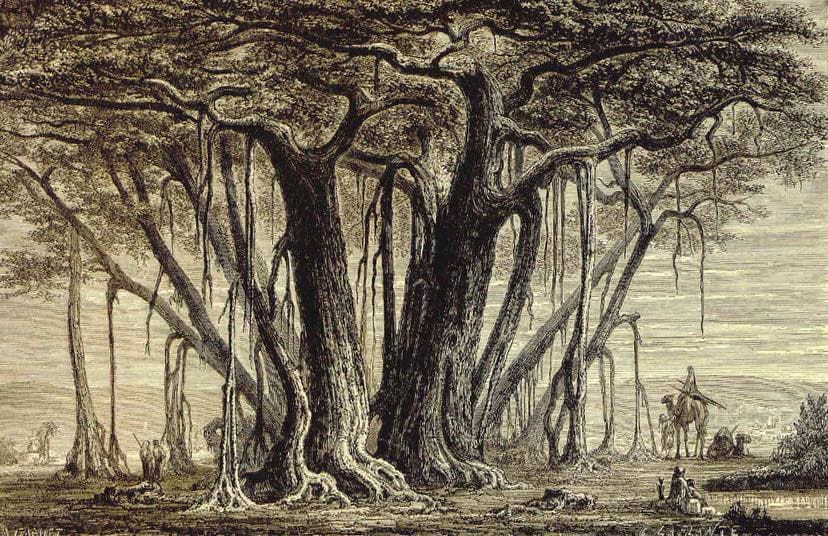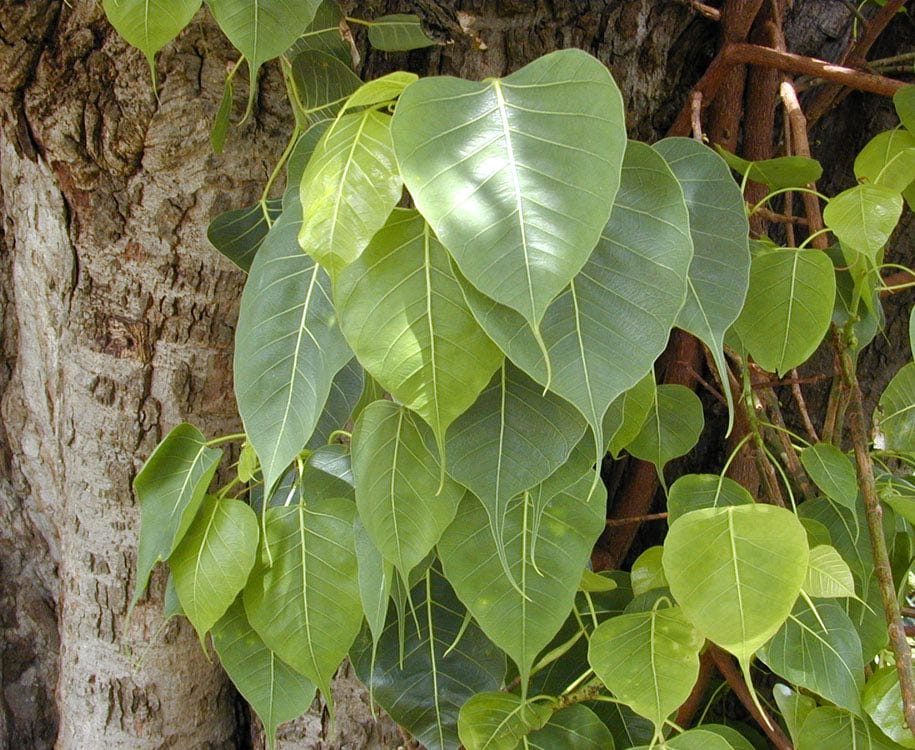Ficus religiosa
Buddha tree, Sacred Fig, Peepal, Bot-treeAshvatha, Bodhidru, Peepal (Ayurveda)
Peepal (Unani)
 Ficus religiosa
Ficus religiosaFiguier, L., The vegetable world [Histoire des plantes], 1867
 Ficus religiosa
Ficus religiosaPhoto by Marshman (Wikimedia)
Botanical name:
Ficus religiosa
Parts used:
Leaf, bark, fruit, root
Temperature & Taste:
Cool, dry
Uses:
BARK:
1. Astringes to Stops Leakage and Bleeding:
-Diarrhea, Dysentery (including that with blood)
-stops Bleeding, Menorrhagia (since Charaka and Sushruta)
2. Astringes Kidney Essence:
-Urinary disorders (Sushruta)
-Leukorrhea, Spermatorrhea
-Beneficial for Premature Ejaculation and to thicken the Semen; Sexual Debility (from loss of essence)
-aerial roots are used to promote conception
-Diabetes
3. Clears Heat and Swellings:
-Glandular swellings of the neck
-skin diseases
-Whooping Cough, Asthma (decoction)
4. Externally:
-paste of bark or tender roots is applied to skin infections
-Ulcers, Fistula
-unhealthy Wounds
-Burns (powdered bark sprinkled over)
-Inflammations (wash, paste)
-paste of the bark and leaves is applied to Stomatitis (Chakradatta)
-paste of the roots applied to the breast firms them up
FRUIT, SEED
-Cough, Asthma
-Poor appetite, Vomiting
-powdered fruit is given to aid conception
LEAF:
-Laxative
–Charaka used leaf bud infusion with honey and sugar for diarrhea
-applied to Wounds
Dose:
Powder: 2–5 grams
In decoction: 6–12 grams
Substitutes:
1. Ficus bengalensis can be used as a substitute.
2. Ficus religiosa bark has been used as a substitute for Ephedra.
Correctives:
1. Sugar, Honey
2. Tragacanth
Comment:
This is revered as a sacred tree and is used in ceremonies and ritual for protection, fertility, wisdom, development, and to raise the character of a person.
Main Combinations:
Four Figs
In some Ayurvedic preparations, the leaf and/or barks of the ‘4 Figs’ are combined: Ficus religiosa, F. bengalensis, F. racemosa/glomerata, F. lacor/retusa).
Panchkshiri Vrkshas: the Five Latex-Bearing Trees
A fifth is added to the above group, traditionally Thespesia populnea (which is replaced by Salix caprea in some texts). These five are called Panchkshiri Vrkshas (the five latex-bearing trees). Together, they are astringent, hemostatic and anti-inflammatory, used for diarrhea, dysentery, skin diseases, ulcers, leukorrhea etc. They are also regarded as promoting Fertility and are useful in Diabetes.
1. Aphrodisiac, fruit, leaf-bud, bark and root are together boiled in milk with sugar and honey added.
2. Blood diseases, Syphilis, non-healing Ulcers, Ficus religiosa bark with Neem, Catechu, Adhatoda, Triphala and Bdellium (as in Varadi Guggulu)
3. Severe colic, decoction of the root-bark with Salt and Jaggery.
4. Topical oil for Skin diseases including Erysipelas, Eczema, Itching and Boils, Ficus religiosa bark with Costus, Madder, Red Sandalwood and Triphala, decocted in Sesame oil with juices of Fumitory and Turmeric root (as in Nalpamaradi Taila)
Major Formulas:
Varadi Guggulu
Nalpamaradi Taila
Cautions:
1. Avoid in constipation. Long-term use dries the body.
Main Preparations used:
Click the tabs above for more information on this Medicine
|
1. ANTIBACTERIAL: –Mousa, 0. et al.: J. Ethnopharmacol. 1994, 41 –Mousa, 0. etal: PlantaMed. Suppl. 1992, 58 2. ANTI-VIRAL: –Hattori, M. etal.: Phytother. Res. 1995, 9 –Dhar, M. L. et al.: Indian J. Exp. Biol. 1968, 6 3. ANTI-FUNGAL: –Pandey, D. K. etal: Phytopathol. Z. 1982, 105 4. CYTOTOXIC: –Hattori, M. etal.: Phytother. Res. 1995, 9 |
5. PROTEASE INHIBITION: –Kusumoto, I. T. etal.: Phytother. Res. 1995, 9, 180. 6. ESTROGENIC: –Ray, B. N. et al: Indian J. Physiol. Allied Sci. 1967, 20 7. ANTI-HYPERGLYCEMIC: –Brahmachari, H. D. etal: J. Pharm. Pharmacol. 1962, 14, 617. |
